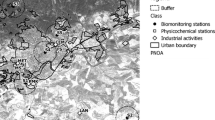Abstract
The degree of heavy metal (Hg, Cr, Cd, and Pb) pollution in honeybees (Apis mellifera) was investigated in several sampling sites around central Italy including both polluted and wildlife areas. The honeybee readily inhabits all environmental compartments, such as soil, vegetation, air, and water, and actively forages the area around the hive. Therefore, if it functions in a polluted environment, plant products used by bees may also be contaminated, and as a result, also a part of these pollutants will accumulate in the organism. The bees, foragers in particular, are good biological indicators that quickly detect the chemical impairment of the environment by the high mortality and the presence of pollutants in their body or in beehive products. The experiment was carried out using 24 colonies of honeybees bred in hives dislocated whether within urban areas or in wide countryside areas. Metals were analyzed on the foragers during all spring and summer seasons, when the bees were active. Results showed no presence of mercury in all samples analyzed, but honeybees accumulated several amounts of lead, chromium, and cadmium. Pb reported a statistically significant difference among the stations located in urban areas and those in the natural reserves, showing the highest values in honeybees collected from hives located in Ciampino area (Rome), next to the airport. The mean value for this sampling station was 0.52 mg kg−1, and July and September were characterized by the highest concentrations of Pb. Cd also showed statistically significant differences among areas, while for Cr no statistically significant differences were found.
Similar content being viewed by others
Explore related subjects
Discover the latest articles, news and stories from top researchers in related subjects.Avoid common mistakes on your manuscript.
Introduction
Honeybee (Apis mellifera) is an insect that directly depends on toxicological conditions of the natural environment. It is a good biological indicator as it is widespread and sensitive to environmental changes, monitoring the level of soil, water, plant, and air pollution in areas of several square kilometers. Since 1970, bees have increasingly been used to monitor heavy metal environmental pollution as reported in some studies [1].
Heavy metals are released into the environment by natural and anthropic sources, and as they do not decay and are characterized by latent toxicity, they are continuously present in the environment entering into the biological cycles. Generally, they do not cause bee mortality but can accumulate in their body. The possibility of using bees as bioindicator of environmental pollution takes advantage of covering the large area where they live and of detecting the presence of heavy metals that are harmless to them. While mechanical fixed-position instruments give punctiform values, the honeybees provide data over the area covered during foraging. As suggested by Leita et al. [2], a network of apiaries located next to polluted areas can supply data for the constant monitoring of heavy metal emissions from pinpoint sources. Bees are characterized by extremely high mobility, and they are continuously exposed to pollutants both coming from contaminated air and those naturally present in the environment. Furthermore, they are easy to collect and they are sensitive to environmental changes and to anthropogenic activities responsible for disturbing environmental equilibria. In case of compounds that are not particularly toxic to bees, the honeybee acts as an indirect indicator and will provide with information in form of residues [3, 4].
Heavy metals present in the atmosphere can directly deposit on the hairy body of the bees or can reach the insect by the nectar, the pollen, the honeydew, or through the water during foraging. The foragers commonly fly within 1.5 km of their hive but they can range over long distances, even up to 10 km, depending on their need for food and its availability. Each forager completes 12 to 15 foraging trips a day. Upon return to the hive, the nest mates in the hive fan the air furiously with their wings by releasing the pollutants in the hive.
These insects are unbiased samplers which can be used for detecting organic and inorganic pollutants in the environment. The family of bees can be easily bred with modest food requirements, and because bees show a very high reproduction rate and a relatively short average lifespan, it is generally possible to collect a sufficient number of samples.
Total daily activity of the bees depends on the weather conditions. The honeybees are able to forage over a 30°C range of air temperature largely because they have behavioral and physiological mechanisms for regulating the temperature of their flight muscles, but the optimal air temperature for foraging is 20–25°C. Below 7–10°C, bees become immobile due to the cold, and above 38°C bee activity slows down due to heat. Even if honeybees can supply a suitable amount of biological material to be sampled and analyzed throughout the year [5], the use of bees as bioindicators should be carried out during the period of sufficient flight activity.
The purpose of this investigation is the use of honeybees as bioindicators to assess the levels of four heavy metals, Pb, Hg, Cr, and Cd, in sampling sites characterized by different environmental impacts. The site surveys were performed in two regions of different degree of environmental pollution: the Abruzzi, known for unpolluted areas as wildlife reserves and agricultural-forest sites, and Latium, characterized by more industrialized and anthropogenic areas, above all near Rome.
Materials and Methods
Sample Collection
The research was run from May to October 2007. The apiaries were localized in two different Italian regions, Abruzzi and Latium, and dislocated whether within urban or industrial areas or in wide countryside areas. Four sampling sites (numbers 2, 3, 4, and 5) were selected as unpolluted areas because they are located inside wildlife reserves (Riserva dei Calanchi di Atri, Abruzzi) and a considerable distance from pollution sources, while sites 6 and 7 were inside the Castelporziano reserve (Latium), but not too far from the main thoroughfare. One site (number 8) was located next to Ciampino airport (Latium), characterized by intense air traffic and motor vehicle circulation, and the last site (number 1) was chosen in a moderately polluted area, near a small road and an incinerator (Abruzzi). Each sampling station consisted of three healthy beehives (n = 3), Dadant–Blatt type, at 10 combs. The hives were of wood and turned towards the southeast, with consideration of the direction and intensity of dominant winds.
Sample collection was carried out once a month in the late morning, without the use of a smoker. The incoming foragers were sampled, using some plastic bags, by closing the entrance of the hive and immediately stored in dry ice.
Sample Analysis
The bees were cleaned from pollen and from the drones before the analysis. Each sample was divided into two aliquots; the first of about 2 g was used to determine the moisture and the remaining aliquot was lyophilized. About 0.7 g of lyophilized sample was homogenized in a glass mortar and then mineralized following the UNI EN 13805 (2001), using concentrated nitric acid (7 mL) and 30% of hydrogen peroxide (1.5 mL).
Quantitative determination of lead, chromium, and cadmium was performed by atomic absorption spectrometry (Perkin Elmer AAnalyst 800) equipped with a graphite furnace (THGA 800), following the UNI EN 14083 (2003), while the total mercury concentrations [6] were measured using a thermal decomposition amalgamation and atomic absorption spectrometry (Milestone DMA80).
Calibration curves were built using dilutions of standard solutions. Quantification limit for Hg and Cd was 0.01 mg kg−1, for Cr 0.05 mg kg−1, and for Pb 0.04 mg kg−1. Table 1 summarizes the analytical conditions.
Statistical Analysis
For all samples with concentrations below limit of quantification, zero was used in the calculation [7]. Normality of data of heavy metals, calculated on a dry basis, was assessed by means of Kolmogorov–Smirnov test. In some compounds, data were not normally distributed; therefore, they were log transformed and normality was reassessed. Then, two-way analysis of variance was performed to detect significant differences among groups (according to sampling site and season) using the statistical package SPSS 14.0.2 (SPSS Inc., Chicago, IL, USA). Moreover, given the low number of replicates, the non-parametric Kruskal–Wallis and Jonckheere–Terpstra tests were also used for several independent samples with Monte Carlo exact test extension with the same statistical package.
Results
The levels of Cd, Cr, and Pb found in the samples are reported in Tables 2 and 3. This study showed that various quantities of heavy metals were accumulated in honeybees and that, for some of them, the levels depended on the sampling area. Hg was the only toxic element that, in all samples, was never detected. Independently from the origin of the samples, Cr showed the highest mean concentrations (0.74 mg kg−1) with respect to the tested heavy metals (p < 0.01). Considering the location of the sampling stations, no significant difference was detected among the different sites (p > 0.05), though the absolute highest value of 5.07 mg kg−1 was found in the sampling station 1 during the month of July. The levels of Cr found in samples coming from sites 2, 3, 4, and 5 vs. 6 and 7 did not show significant differences (p > 0.05), although the sampling sites were located in different regions.
Independently from the origin of samples, Cr was reported to be the highest mean concentration (0.97 mg kg−1) in bees collected during August, while the lowest concentration was found in October (mean value of 0.33 mg kg−1). Indeed, August concentration differed significantly with that of September (p < 0.05) and October (p < 0.01) but not with those in the other months (p > 0.05).
Cd was detected in the great number of samples but at very low concentrations. Samples coming from the inside of the natural wildlife reserve (stations 2, 3, 4, and 5) reported a statistically significant difference (p < 0.01) when compared with those found in samples coming from stations 6, 7, and 8. These bees also reported the Cd lowest mean value (0.04 mg kg−1). The temporal trend for Cd was not of particular interest. This metal did not show any statistically significant difference of distribution in comparison among months (p > 0.05).
For Pb, independently from the sampling month, honeybees caught in the hives located near Ciampino airport (site number 8) showed a significant difference (p < 0.01), with a lead mean value of 0.52 mg kg−1, compared with all other bees coming from the sites 1, 3, 6, and 7 but not with those of sites 2, 4, and 5 (p > 0.05). Pb concentrations did not show peak values in a particular month; on the contrary, they were distributed in a homogeneous manner during all months (p > 0.05).
Discussion
This study highlights Cr as a heavy metal very widespread in the environment. Generally, it is released into the atmosphere by both natural and anthropogenic processes, estimating that approximately 75,000 tons of Cr are annually released into the atmosphere due to the anthropogenic activities which account for 60–70% of total emissions (e.g., steel manufacturing, leather tanning, industrial utilities, wood preservation, chrome plating production, and fossil fuel combustion). On the other hand, approximately 54,000 tons of Cr is estimated to be annually added into the environment via natural sources [8]. Since there are no metallurgical and chemical manufacturing industries in sampling site 1, the amount of Cr could have been released from an old refractory brick plant present in this area or atmospheric Cr-containing particles could have arrived from different distances due to the wind. Generally, Cr concentrations at any particular time and location depend on the intensity of industrial processes, proximity to the sources, the amount of Cr released, and meteorological factors. The atmosphere is a major pathway for long-range transfer of Cr to different ecosystems, considering that the distance covered by the metal depends on meteorological factors, topography, and vegetation [9].
Despite each expectation, Cr resulted to be less present in the honeybees coming from Ciampino area (site 8) than in those coming from conservation areas. The historical uses of chromium probably have resulted in its widespread release into the environment. In particular, a recent study showed that, between 1990 and 2000, the mean Cr concentrations in mosses generally decreased in central European countries; however, they increased in other countries such as Iceland, Italy, Lithuania, Slovakia, Spain, and UK [10]. In the same years, a dramatic decline in the concentrations of lead (57%) and cadmium (42%) in mosses was found across Europe [11].
Regarding cadmium in the European Union and worldwide, approximately 85–90% of total airborne cadmium emissions arise from anthropogenic sources, mainly from smelting and refining of non-ferrous metals, fossil fuel combustion, and municipal waste incineration. The low levels found for Cd in all honeybees, independently from the samples’ origin, support the new trend observed for this metal in several areas of northern Europe where a downward trend in both the air concentrations and the deposition rates was observed from the mid-1970s to the end of the 1980s.
In this study, the lead levels show a typical distribution bind to the anthropogenic development of the areas. In fact, the highest concentrations of Pb have been found near Ciampino airport (site 8), an urban and industrialized area. The presence of Pb in this area could be due to the resuspension of lead-contaminated soil dust.
Honeybees provide a cheap and effective method for monitoring temporal trends in heavy metal pollution, but it should be considered that there are differences in the accumulation of individual heavy metals in bees and that the heavy metal concentrations are also affected by meteorological factors and by different types of vegetation, other than atmospheric pollution.
Conclusion
There are few reports of heavy metal pollution on bees. For the Latium region, our results showed mean values of Pb lower than those reported by Conti and Botrè [12]. An opposite trend is reported for Cd and Cr that showed respectively lower mean concentrations and higher mean concentrations. Our data confirm a decline in Cd values and an increase in Cr concentrations. The data obtained from this study do not allow any specific conclusions concerning the extent of bioaccumulation of mercury, chromium, cadmium, and lead in the environment, but showed the capacity of bees to detect the heavy metal concentrations in the reserves, considered “clean” areas, also when the beehive was located far from any possible pollution source. Bees are one of the most important elements of agriculture because they are one of the most widespread and efficient pollinators. For this reason, the effects of pollution on bees are an ever-growing area of interest for many scientists who fear that bee populations may be at risk from human activity. These “angels of agriculture” are able to detect an early warning of changing environmental conditions and could be an attractive way to assess anthropogenic changes during long periods. The “Colony Collapse Disorder” is the most recent bittersweet reminder that human society threatens honeybee habitats on a global scale and the use of honeybees as monitoring instrument could be well suited to investigate the degree of contamination in the environment.
References
Celli G, Maccagnani B (2003) Honey bees as bioindicators of environmental pollution. Bull Insectol 56:137–139
Leita L, Muhlbachova G, Cesco S, Barbattini R, Mondini C (1996) Investigation on the use of honeybees and honeybee products to assess heavy metals contamination. Environ Monit Assess 43:1–9
Porrini C, Ghini S, Girotti S, Sabatini AG, Gattavecchia E, Celli G (2002) Use of honeybees as bioindicators of environmental pollution in Italy. In: Devillers J, Pham-Delegue MH (eds) Honeybees: estimate the environmental impact of chemicals. Taylor & Francis, London, pp 186–247
Celli G (1994) L'ape come indicatore biologico dei pesticidi. In: D'Ambrosio MT, Accorti M (eds) Atti del Convegno: "L'ape come Insetto Test dell'Inquinamento Agricolo" P.F "Lotta Biologica e Integrata per la Difesa delle Colture Agrarie e delle Piante Forestali", March 28th, 1992, Florence, Italy. Ministero Agricoltura e Foreste, Rome, pp 15–20
Bogdanov S (2006) Contaminants of bee products. Apidologie 37:1–18
EPA Method 7473 (1998) Mercury in solids and solutions by thermal decomposition amalgamation and atomic absorption spectrometry
Voorspoels S, Covaci A, Maervoet J, De Meester I, Schepens P (2004) Levels and profiles of PCBs and OCPs in marine benthic species from the Belgian North Sea and the Western Scheldt Estuary. Mar Poll Bull 49:393–404
Nguyen HT, Kim KH (2008) Chromium concentration levels on the Korean peninsula between 1991 and 2006. Atmos Environ 42:5015–5031
Kotàs J, Stasicka Z (2000) Chromium occurrence in the environment and methods of its speciation. Environ Pollut 107:263–283
Harmens H, Norris DA, Koerber GR, Buse A, Steinnes E, Rühling AA (2007) Temporal trends in the concentration of arsenic, chromium, copper, iron, nickel, vanadium and zinc in mosses across Europe between 1990 and 2000. Atmos Environ 41:6673–6687
Harmens H, Norris DA, Koerber GR, Buse A, Steinnes E, Rühling AA (2008) Temporal trends (1990–2000) in the concentration of cadmium, lead and mercury in mosses across Europe. Environ Poll 151:368–376
Conti ME, Botrè F (2001) Honeybees and their products as potential bioindicators of heavy metals contamination. Environ Monit Assess 69:267–282
Acknowledgments
The authors thank beekeepers Giuliano Cacciatore and Nino Mancini for their excellent cooperation and helpfulness. Pacha Mama, CRA, and IZS are also thanked for their technical support.
Author information
Authors and Affiliations
Corresponding author
Rights and permissions
About this article
Cite this article
Perugini, M., Manera, M., Grotta, L. et al. Heavy Metal (Hg, Cr, Cd, and Pb) Contamination in Urban Areas and Wildlife Reserves: Honeybees as Bioindicators. Biol Trace Elem Res 140, 170–176 (2011). https://doi.org/10.1007/s12011-010-8688-z
Received:
Accepted:
Published:
Issue Date:
DOI: https://doi.org/10.1007/s12011-010-8688-z




